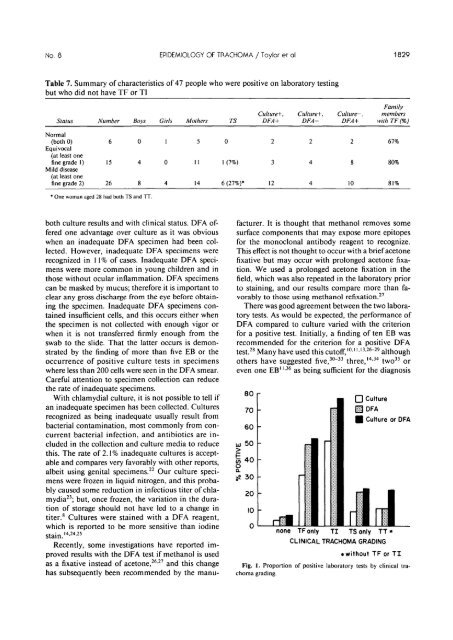The Epidemiology of Infection in Trachoma - Investigative ...
The Epidemiology of Infection in Trachoma - Investigative ...
The Epidemiology of Infection in Trachoma - Investigative ...
You also want an ePaper? Increase the reach of your titles
YUMPU automatically turns print PDFs into web optimized ePapers that Google loves.
No. 8 EPIDEMIOLOGY OF TRACHOMA / Taylor er al 1829<br />
Table 7. Summary <strong>of</strong> characteristics <strong>of</strong> 47 people who were positive on laboratory test<strong>in</strong>g<br />
but who did not have TF or TI<br />
Status Number Boys Girls Mothers TS<br />
Cultured,<br />
DFA+<br />
Culture*,<br />
DFA-<br />
Culture-,<br />
DFA+<br />
Family<br />
members<br />
with TF (%)<br />
Normal<br />
(both 0)<br />
Equivocal<br />
(at least one<br />
f<strong>in</strong>e grade 1)<br />
Mild disease<br />
(at least one<br />
f<strong>in</strong>e grade 2)<br />
15<br />
26<br />
11<br />
14<br />
0<br />
1 (7%)<br />
6 (27%)*<br />
2<br />
3<br />
12<br />
2<br />
4<br />
4<br />
2<br />
8<br />
10<br />
67%<br />
80%<br />
81%<br />
* One woman aged 28 had both TS and TT.<br />
both culture results and with cl<strong>in</strong>ical status. DFA <strong>of</strong>fered<br />
one advantage over culture as it was obvious<br />
when an <strong>in</strong>adequate DFA specimen had been collected.<br />
However, <strong>in</strong>adequate DFA specimens were<br />
recognized <strong>in</strong> 11% <strong>of</strong> cases. Inadequate DFA specimens<br />
were more common <strong>in</strong> young children and <strong>in</strong><br />
those without ocular <strong>in</strong>flammation. DFA specimens<br />
can be masked by mucus; therefore it is important to<br />
clear any gross discharge from the eye before obta<strong>in</strong><strong>in</strong>g<br />
the specimen. Inadequate DFA specimens conta<strong>in</strong>ed<br />
<strong>in</strong>sufficient cells, and this occurs either when<br />
the specimen is not collected with enough vigor or<br />
when it is not transferred firmly enough from the<br />
swab to the slide. That the latter occurs is demonstrated<br />
by the f<strong>in</strong>d<strong>in</strong>g <strong>of</strong> more than five EB or the<br />
occurrence <strong>of</strong> positive culture tests <strong>in</strong> specimens<br />
where less than 200 cells were seen <strong>in</strong> the DFA smear.<br />
Careful attention to specimen collection can reduce<br />
the rate <strong>of</strong> <strong>in</strong>adequate specimens.<br />
With chlamydial culture, it is not possible to tell if<br />
an <strong>in</strong>adequate specimen has been collected. Cultures<br />
recognized as be<strong>in</strong>g <strong>in</strong>adequate usually result from<br />
bacterial contam<strong>in</strong>ation, most commonly from concurrent<br />
bacterial <strong>in</strong>fection, and antibiotics are <strong>in</strong>cluded<br />
<strong>in</strong> the collection and culture media to reduce<br />
this. <strong>The</strong> rate <strong>of</strong> 2.1% <strong>in</strong>adequate cultures is acceptable<br />
and compares very favorably with other reports,<br />
albeit us<strong>in</strong>g genital specimens. 22 Our culture specimens<br />
were frozen <strong>in</strong> liquid nitrogen, and this probably<br />
caused some reduction <strong>in</strong> <strong>in</strong>fectious titer <strong>of</strong> chlamydia<br />
23 ; but, once frozen, the variation <strong>in</strong> the duration<br />
<strong>of</strong> storage should not have led to a change <strong>in</strong><br />
titer. 8 Cultures were sta<strong>in</strong>ed with a DFA reagent,<br />
which is reported to be more sensitive than iod<strong>in</strong>e<br />
sta<strong>in</strong>. 14 - 2425<br />
Recently, some <strong>in</strong>vestigations have reported improved<br />
results with the DFA test if methanol is used<br />
as a fixative <strong>in</strong>stead <strong>of</strong> acetone, 26 - 27 and this change<br />
has subsequently been recommended by the manufacturer.<br />
It is thought that methanol removes some<br />
surface components that may expose more epitopes<br />
for the monoclonal antibody reagent to recognize.<br />
This effect is not thought to occur with a brief acetone<br />
fixative but may occur with prolonged acetone fixation.<br />
We used a prolonged acetone fixation <strong>in</strong> the<br />
field, which was also repeated <strong>in</strong> the laboratory prior<br />
to sta<strong>in</strong><strong>in</strong>g, and our results compare more than favorably<br />
to those us<strong>in</strong>g methanol refixation. 27<br />
<strong>The</strong>re was good agreement between the two laboratory<br />
tests. As would be expected, the performance <strong>of</strong><br />
DFA compared to culture varied with the criterion<br />
for a positive test. Initially, a f<strong>in</strong>d<strong>in</strong>g <strong>of</strong> ten EB was<br />
recommended for the criterion for a positive DFA<br />
test. 28 Many have used this cut<strong>of</strong>f, 101113 ' 26 - 29 although<br />
others have suggested five, 30 " 33 three, 1434 two 35 or<br />
even one EB I1>36 as be<strong>in</strong>g sufficient for the diagnosis<br />
80<br />
70<br />
60<br />
LU 50<br />
w 40<br />
o<br />
0_<br />
55 30<br />
20<br />
10<br />
Culture<br />
DFA<br />
Culture or DFA<br />
none TFonly TI TS only TT *<br />
CLINICAL TRACHOMA GRADING<br />
• without TF or TI<br />
Fig. 1. Proportion <strong>of</strong> positive laboratory tests by cl<strong>in</strong>ical trachoma<br />
grad<strong>in</strong>g.
















